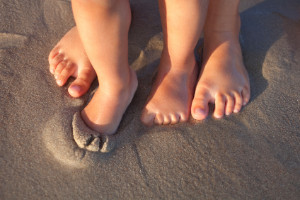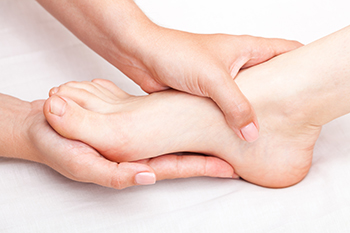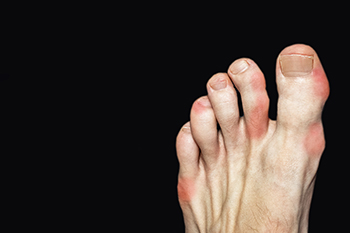Blog
Working On Your Feet While Pregnant

Many individuals throughout the American workforce spend a significant amount of the workday on their feet. For example, cooks, construction workers, and hairstylists spend most of their time on the clock standing on their feet. There are a few things to be mindful of, however, for pregnant women who hold jobs that require them to stand all day. Standing for prolonged periods while pregnant can not only be dangerous, but it can also be difficult or painful. It is recommended that pregnant women stand for no more than four or five hours while taking frequent breaks throughout the workday. Since pregnant women’s feet are prone to swelling, it is more important to listen to your body and give your feet the rest that they need. As the pregnancy progresses, a woman might notice standing becomes increasingly difficult throughout the workday. Pregnant women might choose to lie down during breaks as well as stay hydrated and elevate their feet. Working on one’s feet is certainly nothing to take lightly, particularly if you are pregnant or are planning to be. Consult with a podiatrist for the best advice on maintaining the health of your feet.
While working on the feet, it is important to take the proper care of them. For more information about working on your feet, contact one of our podiatrists from James Kutchback, DPM, CWS-P. Our doctors will treat your foot and ankle needs.
Working on Your Feet
Standing on your feet for long periods of time can cause stress and pain in your feet. Your whole body may experience change in terms of posture, back pain, bunions, callouses and or plantar warts. There are ways to avoid these conditions with proper foot care, smart choices and correct posture.
Positive Changes
Negative heeled shoe – Choosing this shoe type places the heel slightly lower than the ball of the foot. These are great for overall foot health. Find shoes that fit you correctly.
Go barefoot – Our feet were not designed to be enclosed for all hours of the day. Try to periodically expose your feet to air.
Eliminate Pain
Foot Exercises – Performing simple exercises, incorporating yoga and doing stretches are beneficial. This will allow increased blood flow to the area and muscles of the foot.
Achilles tendon – Stretching the foot out flat on the floor will relax the calf muscles and tendon. These exercises can be performed almost anywhere. Make sure you add these exercises to your daily regimen.
With a little bit of this information and knowing more about foot health, you will notice changes. Foot stretches and proper footwear will help with pain and prevent further issues.
If you have any questions please contact our offices located in The Woodlands and Woodville, TX . We offer the newest diagnostic and treatment technologies for all your foot and ankle needs.
What Is a Plantar Fibroma?

If you notice a bump on the arch of your foot, it may be a plantar fibroma. It is defined as a benign growth that develops in the plantar fascia, which is the band of tissue on the sole of the foot. Its function is to connect the toes to the heels, and contributes to stabilizing the arch. A plantar fibroma can gradually increase in size, and can be present on one or both feet. It may begin as a lesion, and can lead to plantar fibromatosis, which is also known as Ledderhose disease. The common symptoms that many patients experience can be painless bumps in the beginning stages on the arch of the foot, and may eventually become worse if left untreated. It may be uncomfortable to walk or stand for an extended period of time, and wearing shoes may cause friction. Research has indicated it may be unknown why a plantar fibroma may develop, despite possibly being connected to specific medical conditions. These include diabetes, liver disease, or epilepsy. There are several treatment options for this ailment, and it is strongly suggested that you schedule an appointment with a podiatrist who can help you with a plantar fibroma.
A plantar fibroma may disrupt your daily activities. If you have any concerns, contact one of our podiatrists of James Kutchback, DPM, CWS-P. Our doctors can provide the care you need to keep you pain-free and on your feet.
Plantar Fibroma
A plantar fibroma is a fibrous knot in the arch of the foot. It is embedded in the plantar fascia which is a band of tissue that extends from the heel to the toes along the bottom of the foot. There can be multiple plantar fibromas in the feet at the same time. There are no known causes for this condition. If you have a plantar fibroma, there will be a bump in the arch of your foot that cannot be missed. Any associated pain is most often due to a shoe rubbing against the nodule. Non-surgical options, such as steroid injections, physical therapy, and orthotics should be tried first. Surgery is a last resort and is the only thing that will remove a plantar fibroma entirely. Consult with a podiatrist for a proper diagnosis and to determine the treatment regimen that is right for you.
What Causes a Plantar Fibroma?
While there are no specific causes identified, a plantar fibroma can possibly come from genetic predisposition or the formation of scar tissue that forms from healing the tears in the plantar fascia.
What Are the Symptoms of a Plantar Fibroma?
There will be a noticeable lump in the arch of the foot that may or may not cause pain. If pain is felt, it is typically because a shoe is rubbing up against the lump or when walking or standing barefoot.
Treatment and Prevention
A plantar fibroma will not disappear without treatment, but it can get smaller and be a non-issue. If pain persists, a podiatrist examines the foot and when the arch of the foot is pressed, pain can be felt down to the toes. An MRI or biopsy might be performed to help diagnose or evaluate the plantar fibroma. The following non-surgical options are generally enough to reduce the size and pain of these nodules:
- Steroid injections
- Orthotics
- Physical therapy to help apply anti-inflammatory creams on the bump
Surgery is considered if the mass increases in size and the patient continues to feel pain after non-surgical methods are tried.
If you have any questions, please feel free to contact our offices located in The Woodlands and Woodville, TX . We offer the newest diagnostic and treatment technologies for all your foot care needs.
Am I a Candidate for Foot Surgery?

Many people undergo foot surgeries when all other options for have failed. There are several types of foot surgery, which can be successful for permanent relief. An Achilles tendon rupture may require surgery, and this is accomplished by having a 3-inch incision cut at the back of the ankle where the tendon has ruptured. The tendon is sewn together with sutures. After closing the wound, the foot is typically placed in a protective boot as the healing process occurs. Bunion surgery is another common form of foot surgery. A bunion is a bony protrusion of the big toe that can develop from genetic factors or wearing shoes that are too tight. If the bunion becomes painful and completing daily activities becomes difficult, joint fusion may be a viable option. It is done by fusing the joint of the big toe. Another alternative may be to have a joint replacement performed. If you are considering any type of foot surgery, it is strongly advised that you are under the care of a podiatrist who can determine if you are a candidate.
Foot surgery is sometimes necessary to treat a foot ailment. To learn more, contact one of our podiatrists of James Kutchback, DPM, CWS-P. Our doctors will assist you with all of your foot and ankle needs.
When Is Surgery Necessary?
Foot and ankle surgery is generally reserved for cases in which less invasive, conservative procedures have failed to alleviate the problem. Some of the cases in which surgery may be necessary include:
- Removing foot deformities like bunions and bone spurs
- Severe arthritis that has caused bone issues
- Cosmetic reconstruction
What Types of Surgery Are There?
The type of surgery you receive will depend on the nature of the problem you have. Some of the possible surgeries include:
- Bunionectomy for painful bunions
- Surgical fusion for realignment of bones
- Neuropathy decompression surgery to treat nerve damage
Benefits of Surgery
Although surgery is usually a last resort, it can provide more complete pain relief compared to non-surgical methods and may allow you to finally resume full activity.
Surgical techniques have also become increasingly sophisticated. Techniques like endoscopic surgery allow for smaller incisions and faster recovery times.
If you have any questions, please feel free to contact our offices located in The Woodlands and Woodville, TX . We offer the newest diagnostic and treatment technologies for all your foot care needs.
Out-Toeing or Duck-Footedness in Children

As toddlers are learning to walk, their gait may be characterized as duck-footed, or out-toeing. This happens when they walk with their toes pointing outward rather than forward. In many children, this way of walking is temporary. A child will often outgrow this by age six to eight years of age. However, sometimes it can persist into adolescence, or even adulthood, and can lead to more serious complications. Out-toeing is a type of torsional deformity and usually occurs when one of the leg’s two longest bones (the tibia, located between the knee and ankle, and the femur, located between the hip and knee) turn towards the outside of the leg, causing the foot to jut out. This condition can occur in one or both legs. Most often, the child does not experience pain or discomfort with this condition, and it does not affect their mobility. Parents might see that their kid’s shoes wear out or have more obvious scuff marks on the outer edges of the shoes if the child is duck-footed. Causes of out-toeing include genetics, fetal position of the legs in the uterus prior to birth, the resting position of the legs during infancy, and being flat-footed. Rarer reasons for this condition are congenital bone deformity or a hip condition, called slipped capital femoral epiphysis, that causes the ball at the top of the femur to slip backwards. If you are concerned about your child’s gait or you notice that they are experiencing pain, imbalance, or instability when walking, see a podiatrist who can alleviate your concerns or provide treatment options to consider.
Making sure that your children maintain good foot health is very important as they grow. If you have any questions, contact one of our podiatrists of James Kutchback, DPM, CWS-P. Our doctors can provide the care you need to keep you pain-free and on your feet.
Keeping Children's Feet Healthy
Having healthy feet during childhood can help prevent medical problems later in life, namely in the back and legs. As children grow, their feet require different types of care. Here are some things to consider...
Although babies do not walk yet, it is still very important to take care of their feet.
Avoid putting tight shoes or socks on his or her feet.
Allow the baby to stretch and kick his or her feet to feel comfortable.
As a toddler, kids are now on the move and begin to develop differently. At this age, toddlers are getting a feel for walking, so don’t be alarmed if your toddler is unsteady or ‘walks funny’.
As your child gets older, it is important to teach them how to take care of their feet.
Show them proper hygiene to prevent infections such as fungus.
Be watchful for any pain or injury.
Have all injuries checked by a doctor as soon as possible.
Comfortable, protective shoes should always be worn, especially at play.
If you have any questions, please feel free to contact our offices located in The Woodlands and Woodville, TX . We offer the newest diagnostic and treatment technologies for all your foot care needs.
Freiberg’s Disease

Freiberg’s disease, also known as Freiberg’s infarction or Frieberg's infraction, is associated with pain in the forefoot. It has to do with the softening of one of the metatarsal heads and typically occurs in teenagers that are growing. If excessive weight is put on this part of the foot, it can lead to a microfracture of the metatarsal head. Symptoms are swelling and discomfort at the ball of the foot and the joint associated with the affected toe – usually the base of the second toe. It is common for one with this affliction to have a long second toe that sustains repetitive force. A person with Freiberg’s disease might limp during the acute phase of the condition and it can become chronic before it is diagnosed. An X-ray or MRI can be used to help diagnose this disease and it is often treated non-invasively, with proper fitting shoes with a wide toe box and metatarsal pads to offset the pressure on the area. Sometimes a walker boot, cast, and/or anti-inflammatory medication is needed to offset weight bearing. There can be a residual deformity of the joint and discomfort that remains over time. However, rarely is surgery done to clean out the joint or shorten the metatarsal. If you/your child is experiencing pain and swelling near the ball of the foot, it is suggested you consult with a podiatrist who can take proper measures to detect the problem and treat it.
Some foot conditions may require additional professional care. If you have any concerns, contact one of our podiatrists of James Kutchback, DPM, CWS-P. Our doctors can provide the care you need to keep you pain-free and on your feet.
Rare Foot Conditions
The majority of foot conditions are common and can be treated by a podiatrist. Standard diagnostic procedures are generally used to identify specific conditions and treatment can be rendered. A podiatrist also treats rare foot conditions which can be difficult to diagnose and may need extra attention and care.
There are many rare foot conditions that can affect children. Some of these can include:
- Freiberg’s disease
- Kohler’s disease
- Maffucci syndrome
Freiberg’s disease - This can be seen as a deterioration and flattening of a metatarsal bone that exists in the ball of the foot. It typically affects pre-teen and teenage girls, but can affect anyone at any age. Symptoms that can accompany this can be swelling, stiffness, and the patient may limp.
Kohler’s disease - This often targets the bone in the arch of the foot and affects younger boys. It can lead to an interruption of the blood supply which ultimately can lead to bone deterioration. The patient may limp or experience tenderness, swelling, and redness.
Maffucci syndrome - This affects the long bones in a child’s foot leading to the development of abnormal bone lesions. They are benign growths and typically develop in early childhood and the bones may be susceptible to breaking.
A podiatrist can properly diagnose and treat all types of rare foot conditions. If your child is affected by any of these symptoms or conditions, please don’t hesitate to call our office so the correct treatment method can begin.
If you have any questions, please feel free to contact our offices located in The Woodlands and Woodville, TX . We offer the newest diagnostic and treatment technologies for all your foot care needs.
How Pregnant Women Can Manage Foot Pain

Pregnancy changes many things about a woman’s body. In addition to all of the many bodily changes that a pregnant woman experiences, she might notice increasing foot pain. There are a number of reasons for this pain. Most notably, a pregnant woman can gain a significant amount of weight as the baby grows, which essentially puts more pressure on the woman’s feet and changes her gait. There are several ways to manage foot pain during pregnancy. One way is to manage your weight gain. By watching what foods you are eating, you can ensure that you are not putting on any extra weight that will further increase the stress put on your feet. Additionally, since foot pain during pregnancy is often caused by the swelling of the woman’s feet, you might consider elevating your feet to approximately 6-12 inches above your heart. This will encourage blood circulation and promote blood flow to the heart. Lastly, pregnant women can manage their foot pain by being diligent about drinking a significant amount of liquids, like water, and avoiding caffeine. By drinking a lot of water, pregnant women can flush out the salt in their bodies that might cause inflammation in the feet. If you are pregnant or are considering becoming pregnant, then contact a podiatrist for the best recommendations about keeping your feet healthy.
Pregnant women with swollen feet can be treated with a variety of different methods that are readily available. For more information about other cures for swollen feet during pregnancy, consult with one of our podiatrists from James Kutchback, DPM, CWS-P. Our doctors will attend to all of your foot and ankle needs.
What Foot Problems Can Arise During Pregnancy?
One problem that can occur is overpronation, which occurs when the arch of the foot flattens and tends to roll inward. This can cause pain and discomfort in your heels while you’re walking or even just standing up, trying to support your baby.
Another problem is edema, or swelling in the extremities. This often affects the feet during pregnancy but tends to occur in the later stages.
How Can I Keep My Feet Healthy During Pregnancy?
- Wearing orthotics can provide extra support for the feet and help distribute weight evenly
- Minimize the amount of time spent walking barefoot
- Wear shoes with good arch support
- Wear shoes that allow for good circulation to the feet
- Elevate feet if you experience swelling
- Massage your feet
- Get regular, light exercise, such as walking, to promote blood circulation to the feet
If you have any questions, please feel free to contact our offices located in The Woodlands and Woodville, TX . We offer the newest diagnostic and treatment technologies for all your foot care needs.
Foot Problems in Babies

Among things that can go wrong at birth, newborn foot problems are common. Clubfoot describes an array of deformities that cause a newborn baby’s feet to be twisted, pointing down, and inward. About half of babies born with clubfeet have it in both of their feet. Boys are more likely to be born with this than girls. Clubfoot is not painful, but it can cause long-term problems and affect the child’s ability to walk. Another condition affecting newborns is metatarsus adductus. This is detected when a baby’s toes and forefoot are pointed inward, and it is difficult to straighten them. The baby’s sole resembles a bean. Polydactyly means that a baby has an extra toe or toes. This affliction can run in a family but is not necessarily genetic. Congenital vertical talus is an unusual cause of a type of flatfoot in newborns. With this, the sole of the baby’s foot looks like the bottom of a rocking chair. Congenital curly toes occur when a baby’s toes are abnormally rotated and in a bent position. Overlapping toes happen when the baby’s fifth digit (baby toe) crosses over the top of the fourth toe. With proper treatment, these conditions can be corrected or dealt with, sometimes with surgery, in early childhood. If you have a baby born with a congenital foot problem, please consult with a podiatrist for proper diagnoses and treatments.
Congenital foot problems require immediate attention to avoid future complications. If you have any concerns, contact one of our podiatrists of James Kutchback, DPM, CWS-P. Our doctors can provide the care you need to keep you pain-free and on your feet.
Congenital foot problems are deformities affecting the feet, toes, and/or ankles that children are born with. Some of these conditions have a genetic cause while others just happen. Some specific foot ailments that children may be born with include clubfeet, polydactyly/macrodactyly, and cleft foot. There are several other foot anomalies that can occur congenitally. What all of these conditions have in common is that a child may experience difficulty walking or performing everyday activities, as well as trouble finding footwear that fits their foot deformity. Some of these conditions are more serious than others. Consulting with a podiatrist as early as possible will help in properly diagnosing a child’s foot condition while getting the necessary treatment underway.
What are Causes of Congenital Foot Problem?
A congenital foot problem is one that happens to a child at birth. These conditions can be caused by a genetic predisposition, developmental or positional abnormalities during gestation, or with no known cause.
What are Symptoms of Congenital Foot Problems?
Symptoms vary by the congenital condition. Symptoms may consist of the following:
- Clubfoot, where tendons are shortened, bones are shaped differently, and the Achilles tendon is tight, causing the foot to point in and down. It is also possible for the soles of the feet to face each other.
- Polydactyly, which usually consists of a nubbin or small lump of tissue without a bone, a toe that is partially formed but has no joints, or an extra toe.
- Vertical talus, where the talus bone forms in the wrong position causing other bones in the foot to line up improperly, the front of the foot to point up, and the bottom of the foot to stiffen, with no arch, and to curve out.
- Tarsal coalition, when there is an abnormal connection of two or more bones in the foot leading to severe, rigid flatfoot.
- Cleft foot, where there are missing toes, a V-shaped cleft, and other anatomical differences.
- Macrodactyly, when the toes are abnormally large due to overgrowth of the underlying bone or soft tissue.
Treatment and Prevention
While there is nothing one can do to prevent congenital foot problems, raising awareness and receiving neonatal screenings are important. Early detection by taking your child to a podiatrist leads to the best outcome possible.
If you have any questions, please feel free to contact our offices located in The Woodlands and Woodville, TX . We offer the newest diagnostic and treatment technologies for all your foot care needs.
Obesity and Gout

Gout is a form of arthritis that occurs when there are increased levels of uric acid in the blood that is not properly excreted from the body. This uric acid can crystalize and settle in the joints. It is characterized by sudden and severe attacks of pain, swelling, and redness in one or more joints, often the big toe. Gout is sometimes referred to as “a disease of kings” because it often occurred in wealthy men who could afford to overeat and drink alcohol. Weight gain and obesity in adulthood are linked to gout. However, there are many reasons one might develop gout, such as genetics and medical conditions (like kidney disease). The good news is that if one loses weight, gout and gout flares are reduced. Attempt to maintain a healthy body weight through adulthood. If you develop gout, it is suggested that you consult with a podiatrist, who can diagnose the condition and recommend treatment options.
Gout is a painful condition that can be treated. If you are seeking treatment, contact one of our podiatrists from James Kutchback, DPM, CWS-P. Our doctors will treat your foot and ankle needs.
What Is Gout?
Gout is a form of arthritis that is characterized by sudden, severe attacks of pain, redness, and tenderness in the joints. The condition usually affects the joint at the base of the big toe. A gout attack can occur at any random time, such as the middle of the night while you are asleep.
Symptoms
- Intense Joint Pain - Usually around the large joint of your big toe, and it most severe within the first four to twelve hours
- Lingering Discomfort - Joint discomfort may last from a few days to a few weeks
- Inflammation and Redness -Affected joints may become swollen, tender, warm and red
- Limited Range of Motion - May experience a decrease in joint mobility
Risk Factors
- Genetics - If family members have gout, you’re more likely to have it
- Medications - Diuretic medications can raise uric acid levels
- Gender/Age - Gout is more common in men until the age of 60. It is believed that estrogen protects women until that point
- Diet - Eating red meat and shellfish increases your risk
- Alcohol - Having more than two alcoholic drinks per day increases your risk
- Obesity - Obese people are at a higher risk for gout
Prior to visiting your podiatrist to receive treatment for gout, there are a few things you should do beforehand. If you have gout you should write down your symptoms--including when they started and how often you experience them, important medical information you may have, and any questions you may have. Writing down these three things will help your podiatrist in assessing your specific situation so that he or she may provide the best route of treatment for you.
If you have any questions, please feel free to contact our offices located in The Woodlands and Woodville, TX . We offer the newest diagnostic and treatment technologies for all your foot care needs.





